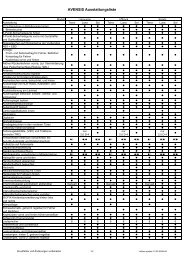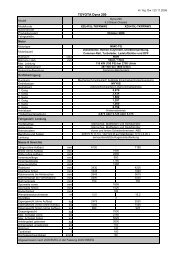tal leadership by maintaining the performance of more than ... - Toyota
tal leadership by maintaining the performance of more than ... - Toyota
tal leadership by maintaining the performance of more than ... - Toyota
Create successful ePaper yourself
Turn your PDF publications into a flip-book with our unique Google optimized e-Paper software.
<strong>Toyota</strong> European Sustainability Report 2011 I Economic Performance<br />
68<br />
4.10 Processes for evaluating <strong>the</strong> highest governance body's own<br />
<strong>performance</strong>, particularly with respect to economic, environmen<strong>tal</strong>,<br />
and social <strong>performance</strong>.<br />
4.11 Explanation <strong>of</strong> whe<strong>the</strong>r and how <strong>the</strong> precautionary approach or<br />
principle is addressed <strong>by</strong> <strong>the</strong> organisation.<br />
4.12 Externally developed economic, environmen<strong>tal</strong>, and social charters,<br />
principles, or o<strong>the</strong>r initiatives to which <strong>the</strong> organisation subscribes<br />
or endorses.<br />
4.13 Memberships in associations (such as industry associations)<br />
and/or national/international advocacy organisations.<br />
Executive remuneration is subject to annual review<br />
and is composed <strong>of</strong> a fi xed salary payment and an<br />
incentive programme that is tied to <strong>the</strong> achievement <strong>of</strong><br />
organisational targets in <strong>the</strong> fi nancial year.<br />
4.14 List <strong>of</strong> stakeholder groups engaged <strong>by</strong> <strong>the</strong> organisation. The key stakeholder groups we engaged with are<br />
employees, customers, suppliers and <strong>the</strong> local<br />
community.<br />
4.15 Basis for identifi cation and selection <strong>of</strong> stakeholders with whom<br />
to engage.<br />
4.16 Approaches to stakeholder engagement, including frequency <strong>of</strong><br />
engagement <strong>by</strong> type and <strong>by</strong> stakeholder group.<br />
4.17 Key topics and concerns that have been raised through stakeholder<br />
engagement, and how <strong>the</strong> organisation has responded to those key<br />
topics and concerns, including through its reporting.<br />
Economic<br />
Disclosures on Management Approach<br />
We focus on <strong>the</strong> stakeholder groups who are<br />
primarily affected <strong>by</strong> our operations or who affect our<br />
organisation.<br />
DMA EC Economic Performance 59-61<br />
DMA EC Market Presence 60<br />
DMA EC Indirect Economic Impacts 59<br />
EC1 Direct economic value generated and distributed. 59-61<br />
EC2 Financial implications and o<strong>the</strong>r risks and opportunities<br />
for <strong>the</strong> organisation's activities due to climate change.<br />
EC3 Coverage <strong>of</strong> <strong>the</strong> organisation's defi ned benefi t plan obligations. Depending on <strong>the</strong> country <strong>of</strong> operation, our operations<br />
in Europe have social security systems that are<br />
competitive in <strong>the</strong> industry and locality where required<br />
<strong>by</strong> local practices.<br />
EC4 Signifi cant fi nancial assistance received from government. None.<br />
EC6 Policy, practices, and proportion <strong>of</strong> spending on locally-based<br />
suppliers at signifi cant locations <strong>of</strong> operation.<br />
EC7 Procedures for local hiring and proportion <strong>of</strong> senior management<br />
hired from <strong>the</strong> local community at signifi cant locations <strong>of</strong> operation.<br />
EC8 Development and impact <strong>of</strong> infrastructure investments and services<br />
provided primarily for public benefi t through commercial, in-kind,<br />
or pro bono engagement.<br />
EC9 Understanding and describing signifi cant indirect economic<br />
impacts, including <strong>the</strong> extent <strong>of</strong> impacts.<br />
The majority <strong>of</strong> our spend is with suppliers based in<br />
Western Europe (35%). This is followed <strong>by</strong> <strong>the</strong> UK<br />
(25%), Eastern Europe (18%), Turkey (17%) and<br />
Japan (5%).<br />
Since our operations are spread across Europe, we<br />
attempt to hire from across <strong>the</strong> region, with a focus on<br />
hiring local people wherever possible.<br />
40-51<br />
45-58<br />
56-58<br />
41<br />
41-45,<br />
47-49,<br />
54-58<br />
42, 43<br />
59-61<br />
55<br />
13,<br />
56-57<br />
59-61

















